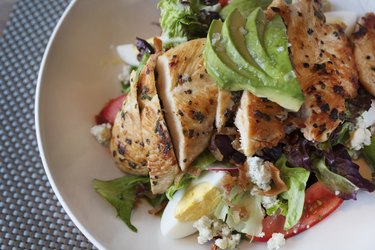
Packed with fresh greens, hard-boiled eggs, tomatoes, chicken, onions, bacon and blue cheese, a Cobb salad is a well-loved dish that appears on many menus in American restaurants. The exact nutrition information depends on the recipe the restaurant you're eating at uses, but general nutrition facts will help you decide if a Cobb salad is really what you want for dinner.
Greens and Vegetables
Video of the Day
Lettuce is a good source of vitamin A and fiber, and one cup of shredded lettuce will only set you back 8 calories. Lettuce or greens, including green leaf lettuce, romaine and spinach, are also a good source of iron and vitamin K, a nutrient that helps clot your blood. Tomatoes are a good source of vitamin C, and 1 cup will also deliver 2.2 grams of fiber and 427 milligrams of potassium. Like lettuce, tomatoes are a nutritious source of vitamins A and K. Onions add fiber, potassium and vitamin C, as well as a burst of flavor, to your Cobb salad.
Video of the Day
The Proteins
A 100-gram portion of cooked chicken, which is about 1/2 cup, adds about 31 grams of protein, which is 67 percent of the protein women need each day and 55 percent of the 56 grams men require daily. White-meat chicken is also low in fat and delivers a good dose of potassium, iron, zinc and niacin, as well. A whole hard-boiled egg supplies an additional 6.3 grams of protein. Eggs are also a good way to add small amounts of iron, zinc and vitamin D to your Cobb salad. Though bacon supplies about 4 grams of protein per slice, one slice also contains 4 grams of fat, of which 1.3 grams are unhealthy saturated fats. A slice of bacon also contains 194 milligrams of sodium.
Blue Cheese
A scattering of blue cheese completes the Cobb salad ensemble, and, with 150 milligrams of calcium per ounce, it's a nutritious addition to your salad. Blue cheese also contributes 110 milligrams of phosphorus per ounce, which is 16 percent of the 700 milligrams you need each day. Phosphorus helps your body absorb calcium. Blue cheese adds protein and vitamin A to a Cobb salad, too. The drawback of blue cheese is that it also increases the sodium content of your salad by 325 milligrams, which is about one-fifth of the 1,500 milligrams you should limit yourself to each day, according to the U.S. Department of Agriculture.
Dressing
French dressing is the traditional dressing for a Cobb salad. A 1-tablespoon serving contains 73 calories and 7.2 grams of fat, of which about 1 gram is saturated. That same serving has 174 milligrams of sodium, but does supply a good amount of vitamin K. Cut the calorie and fat content of your Cobb salad by using reduced-fat French dressing, which contains 36 calories, 1.8 grams of fat, of which almost none is saturated, and 134 milligrams of sodium. Fat-free French dressing or a simple drizzle of olive oil and vinegar are additional dressing ideas that are better for you.
The Healthiest Cobb Salad
A traditional Cobb salad, with the dressing, contains about 623 calories and upwards of 43 grams of fat. Though you also get about 25 milligrams of vitamin C, about 57 grams of protein and 3.5 grams of fiber, you can improve the nutritional value by customizing your salad. Order your Cobb salad heavy on the veggies, which adds fiber, and light on the fatty and salty bacon and blue cheese crumbles. This is a simple way to cut the total fat and sodium content of the salad without sacrificing the flavor you're looking for. If you make a Cobb salad at home, consider using turkey bacon, which isn't necessarily lower in sodium, but is lower in saturated fat. Reduced-sodium bacon is better than regular bacon, as well. Low-fat blue cheese is another option for a homemade Cobb salad.
- U.S. Department of Agriculture: Lettuce, Cos or Romaine, Raw
- U.S. Department of Agriculture: Tomates, Red, Ripe, Raw, Year Round Average
- U.S. Department of Agriculture: Onions, Raw
- U.S. Department of Agriculture: Chicken, Broilers or Fryers, Light Meat, Meat Only, Cooked, Roasted
- U.S. Department of Agriculture: Egg, Whole, Cooked, Hard Boiled
- U.S. Department of Agriculture: Pork, Cured, Bacon, Pre-Sliced, Cooked, Pan-Fried
- U.S. Department of Agriculture: Cheese, Blue
- U.S. Department of Agriculture: Dietary Guidelines for Americans 2010
- U.S. Department of Agriculture: Salad Dressing, French Dressing, Commerical, Regular
- U.S. Department of Agriculture: Salad Dressing, French Dressing, Reduced Fat